Last year was a surprisingly strong year for European new vehicle handling at ports, with particular strength in Germany and surprising resilience even in hard-hit Spain. But increasing imbalance in trade flows is putting pressure on efficiency and the market continues to face uncertainties, writes Anthony Coia. Additional reporting by Christopher Ludwig
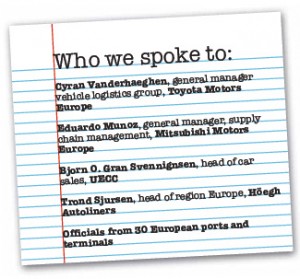 Although the European economy has been sending mixed signals over the past several months, throughput of new vehicles rose last year at almost all of the major vehicle ports. That growth was driven by exports from some regions–notably Germany but also to a lesser degree from markets like the UK–while imports and transhipment to destinations such as Russia helped increase volume in other Northern European ports. Germany also saw significant import growth, although from a lower base than exports. In some areas, import levels dropped off not only because of economic factors but also following the catastrophe in Japan that shutdown a large amount of vehicle production and hence exports.
Although the European economy has been sending mixed signals over the past several months, throughput of new vehicles rose last year at almost all of the major vehicle ports. That growth was driven by exports from some regions–notably Germany but also to a lesser degree from markets like the UK–while imports and transhipment to destinations such as Russia helped increase volume in other Northern European ports. Germany also saw significant import growth, although from a lower base than exports. In some areas, import levels dropped off not only because of economic factors but also following the catastrophe in Japan that shutdown a large amount of vehicle production and hence exports.
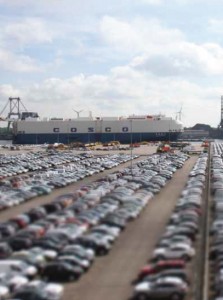 The impact of current eurozone problems on this year’s port throughput is yet to be seen, although most ports are still predicting stable volumes or modest increases. The current situation highlights the economic divide within the European Union, with financial issues in countries such as Greece, Spain, Portugal, and Italy likely to hold back vehicle sales. The growing disparity in Europe’s economy has also been driving a further imbalance between imports and exports, making it more difficult for carmakers and providers to find efficiencies. At the same time, however, new import and export flows offer potential for alternative routes and ports in some cases.
The impact of current eurozone problems on this year’s port throughput is yet to be seen, although most ports are still predicting stable volumes or modest increases. The current situation highlights the economic divide within the European Union, with financial issues in countries such as Greece, Spain, Portugal, and Italy likely to hold back vehicle sales. The growing disparity in Europe’s economy has also been driving a further imbalance between imports and exports, making it more difficult for carmakers and providers to find efficiencies. At the same time, however, new import and export flows offer potential for alternative routes and ports in some cases.
Germany takes the lead
The port of Bremerhaven, in Germany, handled the highest vehicle volume among European ports with a record-breaking 2.05m units last year–surpassing the port of Zeebrugge in Belgium for the first time since this publication began tracking volume. This figure represents a 30% increase compared to 2010, which, to some extent, highlights economic growth on a global level and strong German exports to the United States as well as markets like Brazil, Russia, India and China. But it also highlights the strength of the German economy. Wolfgang Stöver, sales director at terminal operator BLG Automobile Logistics, says one of Bremerhaven’s volume trends is growing imports from German carmakers in the US. These include the BMW X3 model from the Spartanburg, South Carolina plant and a new Mercedes-Benz M-Class model from the Tuscaloosa, Alabama plant.
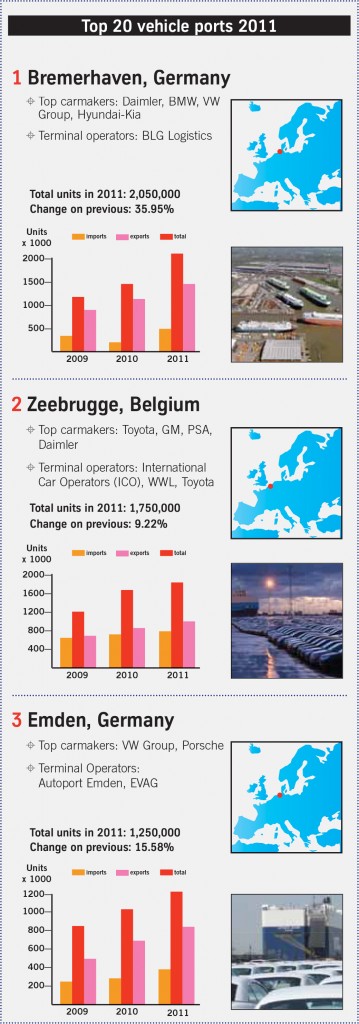 On the other hand, expectations that Chinese-built vehicles would arrive in Europe in higher numbers have not been met. Rather, Stöver points out, China’s exports of Japanese-brand vehicles to Europe are slowing, such as Guangzhou Honda’s Jazz. Transhipments, however, are an increasingly significant component of Bremerhaven’s vehicle trade. “We achieved 38% growth in transhipments from the US and Asia to Russia in 2011. This was due to the economic recovery in Russia as well as increased market saturation that stems from a high degree of financing,” says Stöver.
On the other hand, expectations that Chinese-built vehicles would arrive in Europe in higher numbers have not been met. Rather, Stöver points out, China’s exports of Japanese-brand vehicles to Europe are slowing, such as Guangzhou Honda’s Jazz. Transhipments, however, are an increasingly significant component of Bremerhaven’s vehicle trade. “We achieved 38% growth in transhipments from the US and Asia to Russia in 2011. This was due to the economic recovery in Russia as well as increased market saturation that stems from a high degree of financing,” says Stöver.
The German port of Emden handled 1.25m vehicles last year, maintaining its rank as Europe’s third-largest vehicle port. While Volkswagen Group exports remain the dominant portion of volumes, Joerg Tuitjer, head of the automotive division at terminal operator EVAG, says Emden’s fastest growth has been in three areas: imports from Spain and Mexico; transhipments from Mexico to Europe; and exports to the United States. Tuitjer’s volume prediction for 2012 at the port of Emden is 1.315m units–a relatively small increase. A smaller German port, handling mainly short-sea volumes, also broke into the top 20 for the first time, as the port of Cuxhaven handled more than 350,000 vehicles. The port, which has terminals operated by both Rhenus and BLG, saw its volumes nearly double in the past two years and has attracted new services from short-sea shipping lines like UECC and Flota Suardiaz, according to Oliver Fuhljahn, head of automobile logistics for Rhenus. Imports, which now make up about one third of volumes, grew strongly during the crisis thanks to the scrappage incentive in Germany, but have since kept pace with growth. “The growth in imports has put Cuxhaven and all relevant logistics providers, like trucking and rail companies, in a comfortable position to create partly balanced traffic,” says Fuhljahn.
While some ports in Europe are likely facing the opposite problem, among BLG’s main challenges is a capacity shortage in all transport modes to and from Bremerhaven. Stöver notes that investment has not kept pace with demand for infrastructure and transport equipment. “We are experiencing a demand for more space at the port of Bremerhaven. For exports, we need more storage space for vehicles prior to sailing, and for imports, we need more space for truck distribution to the dealerships. The problem is that the investment situation is more complex than it was before the 2008 economic downturn. Now, as a result of the previous downturn and the current euro crisis, banks are more cautious about loaning money,” Stöver remarks. As part of its solution, BLG continues to invest in rail wagons; it had 800 at the end of last year and its target is 1,400 by the end of 2013. Stöver highlights the importance of rail for transporting cars from lower wage countries in Europe to destinations within Europe or to ports for export. For example, in February Daimler opened a plant in Kecskemet, Hungary, near Budapest to manufacture vehicles destined for Germany, Scandinavia and other countries. Rail would be feasible for distances of at least 500-600km.
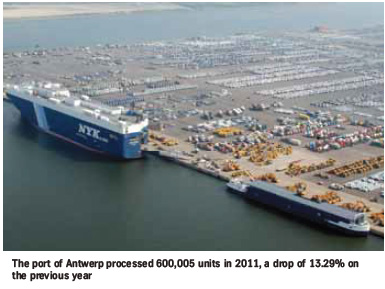 Transhipment central in Belgium
Transhipment central in Belgium
The formerly first-ranked port of Zeebrugge still handled an impressive 1.75m vehicles last year, a 9% increase over 2010. The main reason that it did not keep pace with the port of Bremerhaven was the Japanese earthquake and tsunami in March 2011, which affected volumes from April through September of last year, according to managing director Joachim Coens, as around 35% of Zeebrugge’s throughput comes from Japanese OEMs. Some of this volume should recover in 2012, although the strength of the yen continues to hold back Japanese exports.
The port of Zeebrugge’s main trends include intra- European growth such as short-sea shipments to Spain and Russia. Last year, Mazda added the port of Zeebrugge as a transhipment port to the UK, Spain, Portugal, and Scandinavia. Transhipments represent 30% of the port’s throughput, according to Coens. Zeebrugge is also experiencing growth in overseas trade such as exports from Germany to China, the Middle East, and Mexico. “Overall, we are hoping for a volume increase in 2012, but not by much,” he says.
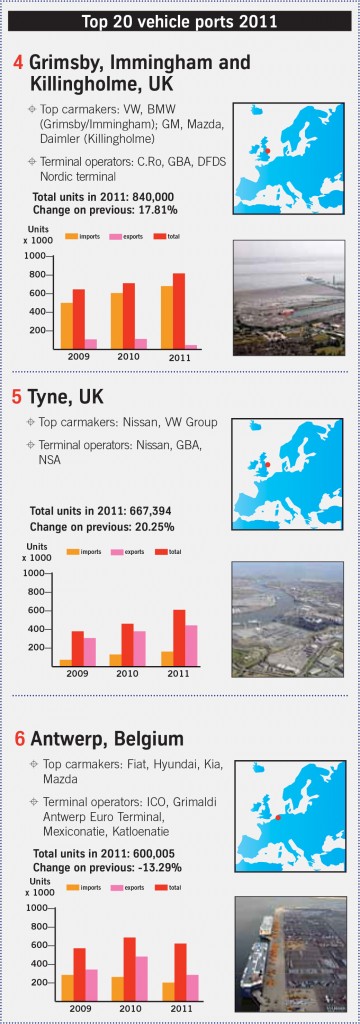 Among the port of Zeebrugge’s challenges is its need for stronger rail connections, particularly from eastern and southern Germany, which are shipping increased export volumes. The port built a new quay wall last year that increased its total length by 1.4km. Coens says it could accommodate four more vessels–two large ones and two smaller ones. Furthermore, in April it plans to open a shunt road connecting the outer port to the inner port, which Coens anticipates will reduce delays and damages to vehicle shipments. Among the users of the port of Zeebrugge is Toyota Motor Europe. According to Cyran Vanderhaeghen, general manager of Toyota’s vehicle logistics group, the carmaker uses two port rotations for its vehicles from Japan. Piraeus (Greece), Livorno (Italy), Sagunto (Spain) and Bristol (UK) are the ports on its south rotation and Zeebrugge and Malmö (Sweden) are the ones on its north rotation.
Among the port of Zeebrugge’s challenges is its need for stronger rail connections, particularly from eastern and southern Germany, which are shipping increased export volumes. The port built a new quay wall last year that increased its total length by 1.4km. Coens says it could accommodate four more vessels–two large ones and two smaller ones. Furthermore, in April it plans to open a shunt road connecting the outer port to the inner port, which Coens anticipates will reduce delays and damages to vehicle shipments. Among the users of the port of Zeebrugge is Toyota Motor Europe. According to Cyran Vanderhaeghen, general manager of Toyota’s vehicle logistics group, the carmaker uses two port rotations for its vehicles from Japan. Piraeus (Greece), Livorno (Italy), Sagunto (Spain) and Bristol (UK) are the ports on its south rotation and Zeebrugge and Malmö (Sweden) are the ones on its north rotation.
Toyota also ships from South Africa to the ports of Vigo (Spain) and Zeebrugge and from Thailand to the ports of Livorno, Piraeus and Zeebrugge, says Vanderhaeghen. “Our objectives are to minimise the number of ports that we use, especially for deep-sea shipments,” he says. Toyota operates its own terminals at the ports of Zeebrugge, Malmö and Sagunto, and maintains a dedicated area at Bristol. While volumes in Western Europe are stagnant, Vanderhaeghen says that Toyota’s main growth has been in short-sea shipments from Malmö to Russia, where it calls the ports of Ust-Luga and St Petersburg. “For the port of Malmö, the challenge is that it was not designed to ship 150,000 vehicles to Russia annually. Although it turned out to be the most economical port location for us, it is becoming too small of a space,” he says.
Vanderhaeghen says that road transport has become a more competitive mode for specific routes that are driven by economic conditions. “For example, Spain exports a lot and imports relatively little. Therefore, where we had shipped by short-sea for some shipments, now we use truck. The reason is that the port of Sagunto was designed for a much bigger volume than what is coming,” he acknowledges.
Balancing flows
For Mitsubishi Motors Europe, the use of short-sea transport is increasing relative to its use of road distribution, according to Eduardo Munoz, general manager, supply chain management. The main reasons are availability, capacity, costs and lead-time. Currently, Mitsubishi uses about 80% truck within Europe and 20% short-sea. Mitsubishi has experienced volume increases at the ports of Zeebrugge for the markets of Benelux, France, and Germany, Kotka for Russia, and Drammen for Norway; other volumes remained stable for the most part, according to Munoz.
“The main trend is a greater imbalance between imports and exports in some ports. Where there are higher exports compared to imports, we see plenty of truck and rail transport available, depending on the port and time,” he says. Mitsubishi imported 120,000 vehicles from Asia last year, and it exported 20,000 vehicles from its plant in Born, Netherlands, although the company recently announced it would end production here at the end of the year. Munoz expects an increase in deep-sea shipments this year from Japan and Thailand. “Since import volumes to Zeebrugge declined last year, including a slight decline in volumes from Eastern Europe, finding return flows from Zeebrugge to the general markets, including Germany, is more difficult,” he says.
 UK ports rebound
UK ports rebound
Ports in the UK also experienced some recovery in 2011. The UK’s leading port amalgamation of Grimsby, Immingham, and Killingholme ranked fourth among Europe’s vehicle ports last year. Volumes at Grimsby and Immingham increased by 15% in 2011, to 640,000 units. This year, the two ports are expecting a 10% increase, according to Jeffe Baker, business development manager. “Our current challenge is to facilitate access through the lock gate at Grimsby, which limits ship size. In order to accommodate larger ships, we are investing £26m ($41m) in a new river facility that is scheduled to open in the summer of 2013. This will involve increasing the draft from 5.8 metres to between 7.5 and 8 metres, thus allowing access for 3,000-car vessels compared to the current 800-car maximum,” explains Baker.
At the neighbouring port of Killingholme, which imported 200,000 units in 2011, C.RO Ports Killingholme expanded its services by adding shipping line North Sea RoRo in January. The short-sea carrier offers three sailings per week between the ports of Gothenburg, Sweden and Killingholme. In northeast England, the port of Tyne broke into the top five European vehicle ports last year, with a volume increase of more than 20% over 2010, according to commercial manager Alasdair Kerr. “Last year was a record for the port of Tyne. Volumes were higher for Nissan, our largest shipper, and Volkswagen, our second largest. Our growth has been due to increased market share in the UK for these vehicle manufacturers as well as increased exports from Nissan [in Sunderland],” he states.
At the port of Southampton–another top ten port whose leading volumes are from Jaguar Land Rover, BMW, and Ford–deputy port manager Clive Thomas says one of its challenges is to reduce dwell time. “The longer that vehicles stay on the ground before being imported or exported, the more storage space is required. Thus, the greatest challenge for Southampton is to ensure that there is enough storage space within the port and near the berths,” he explains. To address this issue, the port of Southampton offers three dedicated multi-deck car garages, with a fourth due for completion by mid-year. Thomas adds that recent upgrades in the port’s rail infrastructure enable it to accommodate longer trains within the port’s Eastern Docks. He notes that the port now regularly accommodates five unit trains per day.
Although overall car volumes are stable at the port of Bristol, in the southwest, imports from Japan declined because of the earthquake and tsunami as well as the strength of the yen, points out Tony Dent, business development manager. “On the positive side, short-sea imports have increased with General Motors and Fiat providing good volumes. Exports to certain European countries, such as Italy, have also grown despite the problems in the eurozone,” says Dent. Moreover, the port of Bristol recently improved its IT system by providing direct links to vehicle manufacturers to confirm the arrival and dispatch of their vehicles through the port.
Connecting Scandinavia
Among Europe’s outer regions with improved connectivity to the rest of the continent and the world is Scandinavia. Yet, it has also experienced some effects from the eurozone crisis. For example, during the first half of 2011, the port of Gothenburg was strong in that volumes increased by 17% compared with the previous year. However, last summer, its car volumes began to decline because of the economic situation in Europe and as Saab stopped production in March and later went into bankruptcy. On the positive side, the port of Gothenburg’s short-sea services to the ports of Ghent and Zeebrugge improved last year, thanks partly to an increase in Volvo volumes. Also in 2011, Logent Ports and Terminals began to operate Gothenburg’s car terminal, mainly handling deep-sea shipments, whereas Älvsborg RoRo handles short-sea shipments. Mikael Myntti, site manager at Logent Ports and Terminals, says that it has partnered with Green Cargo, a major railway operator in Sweden, in a new venture called Logent Automotive Logistics that will offer automobile distribution using multipurpose rail wagons and enabling two-tier vehicle transport. The strategic role of the Grimaldi Group’s Antwerp hub terminal has also enabled a fast connection to Finnlines’ network, mainly to Helsinki and St Petersburg.
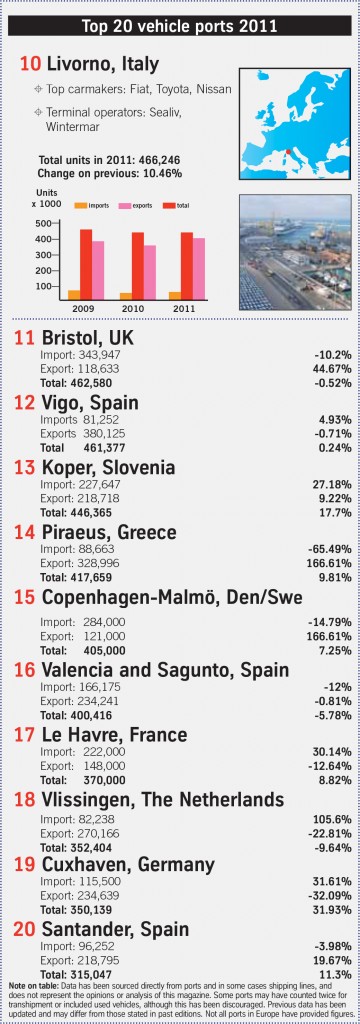 Iberia develops despite tough economy
Iberia develops despite tough economy
Despite the fact that Spain and Portugal are facing economic hardships, some of their vehicle ports have made successful connections for exports, including to the Chinese market. Last year, the seventh-ranked port of Barcelona maintained strong volumes despite the poor Spanish market, as Grimaldi Lines began a new regular service to North Europe. At the port of Barcelona, rail has become an efficient inland transport mode, especially for vehicle exports. Last year, 29% of all vehicles handled at the port moved by rail. Efficiency has improved since the port of Barcelona changed to the European rail gauge in December 2010, according to commercial manager Lluís París. “When the Hutchison Container Terminal moves to a new location in July, about 26 hectares in the car terminal area will be available, which could increase our compound area. On the other hand, we could grant two more berths for vessels, and thus the reliability of vessel scheduling would increase,” says Paris. The port of Barcelona continues to position itself as a Mediterranean hub for car traffic, especially as an import port for several Far East brands, as well as exports of Seat cars to China. A new regular service began in January, making Barcelona the first Spanish port to offer a direct vehicle export service to China. The service began as a monthly one and will increase to twice monthly, according to a port official. In Portugal, the port of Setubal began to export vehicles directly to China last year with twice-monthly shipping. Each shipment is approximately 1,000 Volkswagen vehicles from the AutoEuropa plant in Palmela, near Lisbon, according to port spokesperson João Gonçalves.
Also on the Atlantic coast, the port of Vigo, Spain is developing two new ramps at its terminal. “Whenever the economy and the car industry start to improve, we will be ready to provide more space and better service,” says Dolores Rois Orza, commercial manager. The port is now using high bay (silo) warehousing for its long-stay vehicles to avoid interrupting the flow of its high-turnover vehicles. The €24m ($31m) investment, which opened last year, has increased the terminal’s storage capacity by 4,000 cars. Patricio Arrarte, manager of the ro-ro traffic department at the Spanish port of Santander, on the north coast, says the sudden halt of new car sales in Spain has left import and export traffic imbalanced. Despite these challenges, the port of Santander has increased the length of its trains loading and unloading in the port to 500 metres and hopes to reach 750 metres soon. The Port Authority of Valencia, located on Spain’s central Mediterranean coast, is responsible for the management of two ports that handle new cars: Valencia and Sagunto, about 25km apart. At the port of Valencia, the backbone of its new vehicle throughput has been export volumes from Ford’s nearby plant, although imports have increased slightly as a relative percentage of the total, according to Jorge Civera, commercial department junior. The port of Valencia has built railway access to its east quay. Now, the Ford plant connects to the port by rail, which will move units from the factory to the port.
To improve throughput efficiency, the ports of Valencia and Sagunto recently implemented an automated customs clearance system and other related features. Furthermore, Civera expects transhipment volumes to also increase, with a new ocean line calling the port of Sagunto this year.
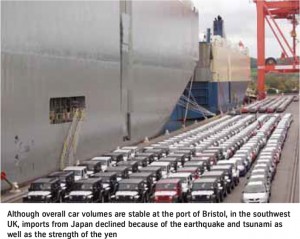 Ups and downs
Ups and downs
At the port of Piraeus, which is largely a transhipment port and a hub for Middle East, North Africa and Black Sea destinations, the total throughput increased by nearly 10% last year. However, imports declined significantly because of Greece’s economic crisis. Spokesperson Athanasios Karlis says that as transhipment volumes increase, Piraeus’ yard operations need to improve in terms of its storage period and yard area. The port of Piraeus recently expanded its G2 terminal by 20,000m2. An additional berth of 369 metres is now serving car carriers exclusively. Bjorn O. Gran Svennignsen, head of car transport sales at short-sea shipping line UECC, says that labour strikes in Greece, Spain and Belgium have affected its operational efficiency. The company has seen steady growth in Zeebrugge, and it has been experiencing its fastest growth in Russia, where it serves the ports of St Petersburg and Ust-Luga. UECC has also experienced growth at the Turkish ports of Derince and Yenikoy for Ford, and Borusan. “However, we expect the Turkish market to cool in 2012 due to market saturation and higher interest rates on loans,” Svennignsen predicts. Among UECC’s main challenges are rising costs and customs issues between European Union and non-European Union countries such as Russia, Turkey and the North Africa region.
The port of Koper, Slovenia is anticipating 9% growth in its car volume this year, according to Gregor Belic, car terminal director. Koper plans to establish an additional dedicated berth for ro-ro operations by rearranging the existing berth and adjacent storage area. Recently, the port adapted an existing berth for car-carrier operations and it expanded its auto processing facility. The result is greater storage capacity and higher productivity. At the port of Rotterdam, imports increased by 30% and exports by 10% last year, compared to 2010. Sjors Bosvelt, general manager of Broekman Car Handling, says the port is benefiting from the free trade agreement between the EU and South Korea, which has increased imports to Rotterdam. “We also expect Japanese imports to increase following the drop due to the earthquake and tsunami, but currency exchange rate is essential,” says Bosvelt.
Last year, Broekman acquired certification as an Authorised Economic Operator (AEO), which improves customs efficiency and enables more efficient handling of its vehicles. Volumes at the port of Amsterdam, whose main customer is Nissan, have been stable during the past two years. Its main volume from the UK comes from the Sunderland plant. “For the Renault Nissan Alliance, plants are locating more in Russia, which creates the need for water transport,” says Alain Bresseleers, managing director of Koopman Car Terminal. “Since the port of Amsterdam has no regular exports, the challenge is to create them, such as from Japan to the UK via Amsterdam. It is optimal to load with exports when imports arrive, but the vessels are going back empty to the UK,” says Bresseleers.
 French and Italian ports
French and Italian ports
The port of Le Havre experienced a volume increase of 10% last year and expanded its car terminal to accommodate the growth. In September, it added 20 hectares to its storage area for a total of 100 hectares. Hervé Cornède, commercial director says its target is to add 20 additional hectares in two years. Le Havre’s main markets are France and Germany. “Imports are remaining at the port longer, which is an industry trend. This makes us a better location for providing pre-delivery inspection (PDI) services,” says Cornède. He predicts that the port of Le Havre’s imports, which represent 60% of its total vehicle throughput, will be a relatively higher percentage within the next five to seven years. Other trends are increased exports to Eastern Europe and North Africa. “We are also seeing a slight shift toward barge and an increase in short-sea transport; this is in line with our goal to be more environmentally-friendly,” he says. At Italy’s largest port of Livorno, the main goal is to increase the volume of new cars by rail delivery, especially those with a final destination in Central and Southern Europe, according to Saverio Failli, who heads the port’s office of economics and statistics. This would represent a significant change since at this point all new vehicles move by truck. Last year, the port of Livorno established two new car operators; Southern European Auto Logistics Livorno (Sealiv); and Wintermar. “In the past, all the new cars imported or exported by the port of Livorno were handled and managed by the Port Workers’ Company,” he says.
Ocean carrier strategies
Ocean car carrier Höegh Autoliners’ main export ports are Bremerhaven, Hamburg, Southampton, Le Havre, Antwerp, Santander and Barcelona, as well as feeder ports. Its four main services are a weekly route to Africa/Indian Ocean, Australia and New Zealand; bi-weekly to Caribbean, Mexico, and Cuba; bi-weekly to Southeast Asia and Japan, and bi-weekly to the Middle East and India. For short-sea shipment, Höegh Autoliners and MOL formed a joint venture called EML that serves three main corridors: UK to the Baltic Sea and Russia; northern Spain and Turkey; and the Morocco continent sling. “The establishment of EML gives us a strong foothold in the short-sea market in Europe and gives Höegh Autoliners a much larger footprint in the vehicle logistics market in Europe,” explains Trond Sjursen, head of region Europe.
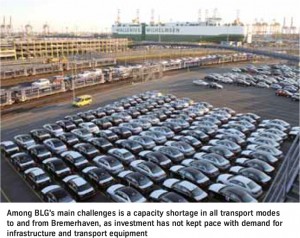 Sjursen says that Höegh Autoliners’ short-term objectives are to optimise its inbound and outbound schedules to be able to load and discharge at the same ports and thereby save on separate load or discharge calls. “For the longer term, we are working on projects to deliver to European ports more efficiently. These include a plan for a Mediterranean hub and port consolidation on the northern continent,” reveals Sjursen.
Sjursen says that Höegh Autoliners’ short-term objectives are to optimise its inbound and outbound schedules to be able to load and discharge at the same ports and thereby save on separate load or discharge calls. “For the longer term, we are working on projects to deliver to European ports more efficiently. These include a plan for a Mediterranean hub and port consolidation on the northern continent,” reveals Sjursen.
Höegh Autoliners is experiencing increased volumes from Europe to South Africa, Australia, India and the Middle East. He predicts that inbound to Europe, volumes will drop as the year progresses. This will place further pressure on the space utilisation for export cargo, which lacks sufficient [capacity]. “Our main challenge is the requirement to follow the decisions of the manufacturers of where to load and discharge their vehicles. Very often, vehicle manufacturers base these decisions on different driving factors from those of the carriers. Inland logistics, change of sourcing, and political issues are often much stronger drivers and influences than are carriers and their need for port consolidation and efficiency. This means that the number of ports to call [at in order to] serve the customer portfolio is larger than we would have liked to see. The work to change this is very slow and takes years to achieve,” states Sjursen.

Such a long view is particularly necessary in the port and shipping industries, it would appear. But this is no bad thing, not least as the industry maintains its wobbly and unbalanced recovery in the shadow of the current economic turmoil in Europe. There remain many challenges to how carmakers and carriers work with ports to optimise logistics efficiency, not least with the growing disparity between inbound and outbound flows at some ports. The numbers for 2012 may not be as impressive as 2011, but there are positive signs at the vehicles ports–from infrastructure improvements to inland connectivity and new routings for deep-sea and short-sea carriers. If the markets hold up, carmakers and providers should see benefits.

























![Global[1]](https://d3n5uof8vony13.cloudfront.net/Pictures/web/a/d/s/global1_726550.svgz)










